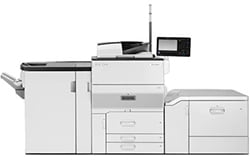Digital Printing Press
Overview
Overview:
lease or Purchase a Digital Press
A Digital Press is a multifunction printer that is able to produce large quantities of advanced documents, quickly. They are usually used by commercial printers, production print companies, print rooms and reprographics departments.
Production printers can use a variety of different print processes with the two most common being lithographic and digital technology. Lithographic or offset printing is a technique in which the inked image is transferred (or “offset”) from a plate to a rubber blanket, then to the printing surface. Litho printing can be done as full colour (CMYK), a single colour (CMYK or Pantone special ink), two colours or a combination of CMYK with additional Pantone spot colours and specials inks, making it a diverse and flexible process able to achieve a variety of desired outcomes. Litho printing is best suited to print runs and quantities over 500 copies up to the thousands and tens of thousands plus.
In contrast, digital printing users laser technology and toner, which is fused to the paper. The digital printing method results in a quicker turnaround time as the process is less complex and requires less ‘make ready’ and preparation. Most modern digital presses have in-built finishing options such as punch, trim, fold and bind units, making print jobs even easier to produce. Digital printing is best suited to smaller print runs typically 1 – 500 copies. Production printers can use a digital press to produce small quantities of still quite complex print jobs.
Many companies believe that litho printing, using a traditional offset printing press is the most cost-effective method of producing large quantities of documents. However, while offset printing is a fantastic way to produce great-looking print projects cheaply, most businesses do not always require large runs of 500 or more identical documents, this is where digital presses come in.
Digital presses are the ideal device for users that need to print small to medium quantities, such as 100 flyers, 30 greeting cards, or a single poster. Digital presses can also be utilised to mail-merge data within a document to produce personalised print ideal for direct mail campaigns and invitations.
Digital presses have a higher cost per page than more traditional lithographic printing methods, but this price is usually offset by avoiding the cost of all the technical steps required to make printing plates. Each individual page using the offset printing method needs a separate plate, which takes both expertise and time to produce at an additional cost.
There are many circumstances where digital printing is a better option than offset printing, below outlines the benefits of each method.
Advantages of Digital Printing
• Setup costs are lower for short runs
• Print only the amount you need, as and when you need it
• Inexpensive for black and white printing
• Variable data capability (names, addresses, codes or numbering can be done easily)
• Colour matching / Pantone reference for exact matching, with minimal user input.
• In-built finishing capabilities to reduce hand finishing
• In-built finishes including laminations and white ink
Advantages of Offset/Lithographic Printing
• Print larger quantities of documents for lower costs
• Price reduces dependent on the number of prints
• A larger variety of paper types, with varying finishes can be used
• Special custom inks such as metallic are only achievable using offset printing
• The quality of the document is greater than digital can achieve
 Ricoh Digital Press Devices
Ricoh Digital Press Devices
Ricoh’s range of digital press printers offer robust solutions for both commercial printers and in-house departments. Ricoh offer two ranges of digital press devices, with cut sheet printers, for printing high quality marketing materials and continuous feed digital presses for companies and printing plants that have very large print jobs such as invoice runs.
 The Ricoh digital presses are ideal for producing incredibly impressive colour rich marketing materials or mailing output. As well as excellent colour, the Ricoh digital presses can accommodate a range of media inputs, including, envelopes, cards and coated papers. Another important aspect of the production machines is the optional finishing options – booklet making, punching and saddle-stitching to name a few. These can hugely increase the output abilities of the device.
The Ricoh digital presses are ideal for producing incredibly impressive colour rich marketing materials or mailing output. As well as excellent colour, the Ricoh digital presses can accommodate a range of media inputs, including, envelopes, cards and coated papers. Another important aspect of the production machines is the optional finishing options – booklet making, punching and saddle-stitching to name a few. These can hugely increase the output abilities of the device.
The most recent feature to hit the market has been the 5th toner element. In addition to the standard cyan, magenta, black and yellow, users can choose a fifth colour – either white or gloss. This can allow the user to create highly professional jobs that other production machines of this level would struggle with.
Speak to an Expert 03332 413 433
Remote Support
Our customer support help-desk technicians will guide you through the next steps,
to assist you with your query.
OneStop Login
(Formerly Callisto)

Search

